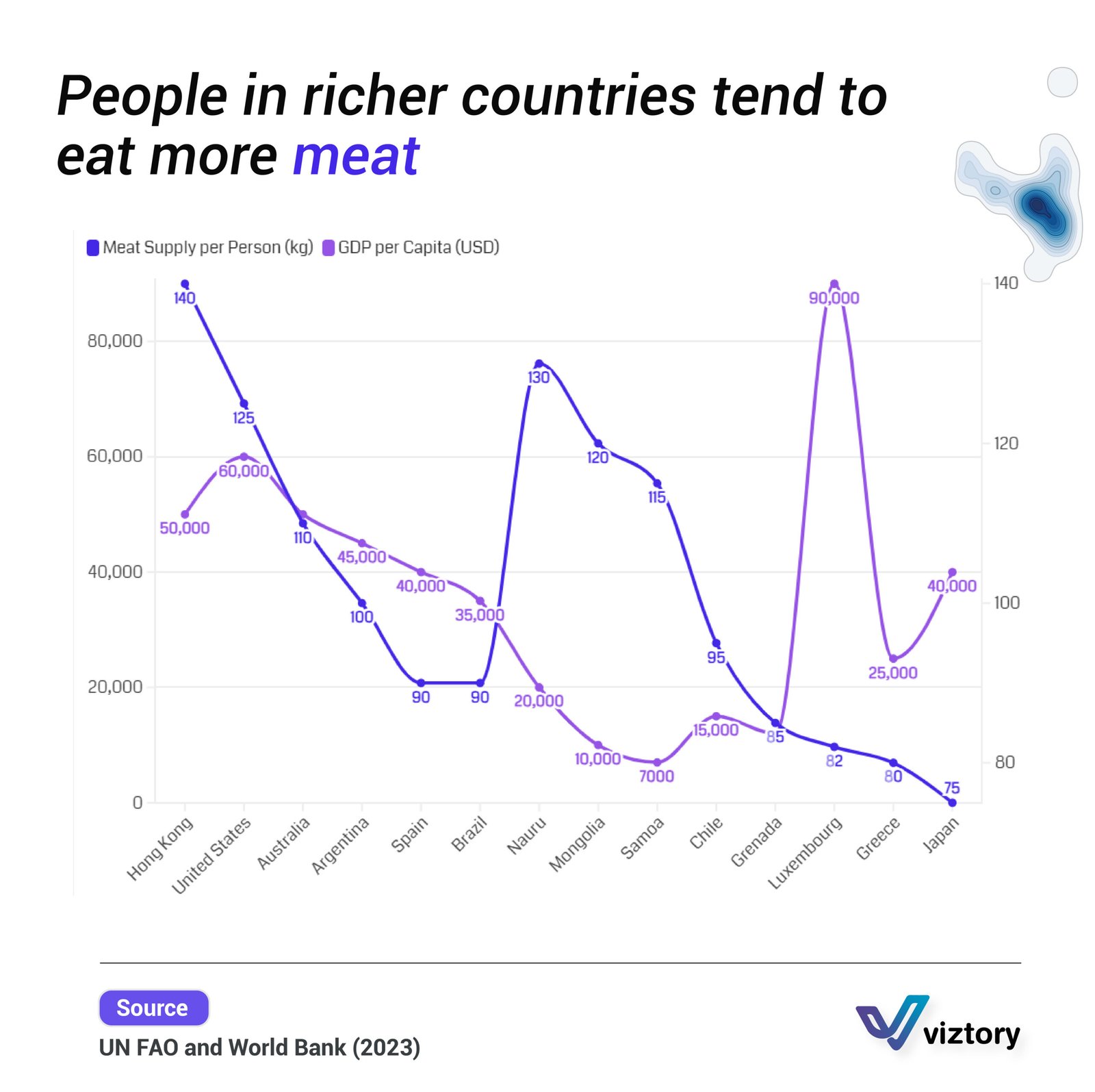The Relationship Between Meat Consumption and Economic Prosperity: A Healthcare Perspective
-
Sep, Thu, 2024
The Relationship Between Meat Consumption and Economic Prosperity: A Healthcare Perspective
The global disparity in meat consumption is a topic of growing interest among healthcare professionals, economists, and policymakers. The provided image highlights the connection between a country’s wealth, measured by GDP per capita, and the average meat consumption per person. The data reveals that citizens of wealthier nations, such as Hong Kong, the United States, and Australia, tend to consume more meat, while those in lower-GDP countries eat significantly less. This correlation prompts important discussions about the health implications of meat consumption in different economic contexts.
Economic Prosperity and Dietary Choices
As seen in the chart, countries with a higher GDP per capita tend to have higher meat consumption per person. For instance, Hong Kong and the United States show both high levels of meat supply per person and a correspondingly high GDP. This pattern suggests that wealth enables access to a wider variety of foods, including meat, which is often more expensive than plant-based alternatives.
However, from a healthcare perspective, this trend raises several concerns. While moderate meat consumption provides essential nutrients such as protein, iron, and vitamins, excessive intake, particularly of red and processed meats, has been linked to various health problems. Studies show that high meat consumption is associated with an increased risk of heart disease, cancer, and obesity. Therefore, wealthier nations may face a paradox where economic prosperity contributes to health risks through dietary choices that are rich in meat.
The Health Impact of Meat Consumption
The differences in meat consumption between countries have clear implications for public health. In high-GDP countries like the United States, where meat consumption is at its peak, healthcare systems are dealing with an increasing prevalence of diet-related diseases such as cardiovascular issues, diabetes, and certain cancers. These nations need to consider policies and public health campaigns aimed at promoting a balanced diet, reducing reliance on meat, and encouraging the consumption of healthier, plant-based alternatives.
Conversely, in lower-GDP countries like Mongolia or Samoa, where both GDP and meat consumption are lower, the healthcare challenges are different. In such countries, meat might be a valuable source of nutrients, especially where access to diverse food sources is limited. However, lower overall calorie intake and undernutrition could present a more pressing healthcare concern. Therefore, healthcare interventions in these regions might focus on ensuring adequate nutrition without necessarily discouraging meat consumption, as it may play an essential role in the local diet.
The Environmental and Ethical Dimensions
Meat consumption is not only a health issue but also an environmental and ethical one. The environmental impact of large-scale meat production, particularly in wealthier countries, is significant. The meat industry contributes to greenhouse gas emissions, deforestation, and water depletion, all of which have direct and indirect effects on public health. Furthermore, ethical considerations about animal welfare in industrial farming systems are becoming increasingly prominent in discussions about dietary choices.
From a healthcare perspective, addressing meat consumption is not only about reducing the risks of chronic diseases but also about ensuring the sustainability of food systems for future generations. Health campaigns in wealthier countries should thus also include messaging on the environmental benefits of reducing meat consumption, alongside the health benefits of adopting more plant-based diets.
Conclusion
The relationship between a country’s wealth and its citizens’ meat consumption, as illustrated in the image, provides important insights into how economic factors influence dietary patterns and their associated health outcomes. While wealthier nations have greater access to meat, healthcare systems in these countries must grapple with the negative health consequences of excessive meat consumption. On the other hand, in lower-GDP countries, meat might serve as a crucial source of nutrition in the face of broader issues of food insecurity.
For healthcare professionals and policymakers, addressing these challenges requires a nuanced understanding of both the economic and cultural factors that shape dietary habits. Encouraging balanced diets that prioritize health and sustainability should be a priority for governments worldwide, regardless of a nation’s wealth.

